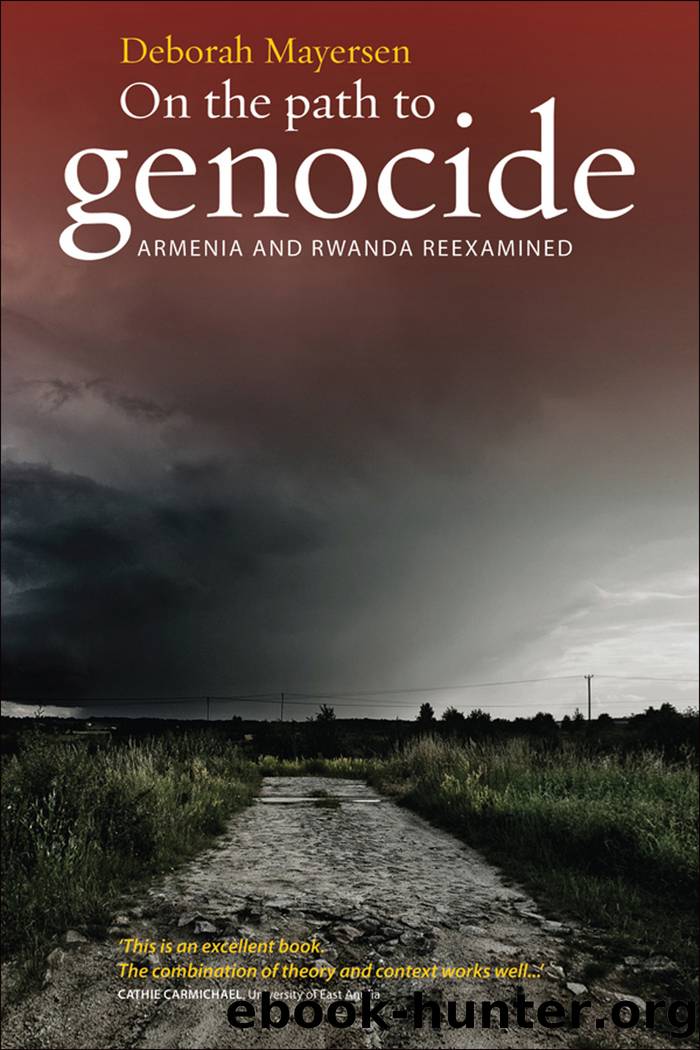On the Path to Genocide: Armenia and Rwanda Reexamined by Deborah Mayersen

Author:Deborah Mayersen [Mayersen, Deborah]
Language: eng
Format: epub
Tags: Modern, Genocide & War Crimes, 20th Century, Political Science, History
ISBN: 9781782382850
Google: ZHAXAwAAQBAJ
Goodreads: 23098390
Publisher: Berghahn Books
Published: 2014-04-01T00:00:00+00:00
The Rwandan Revolution
Rwanda has been described as a âsimmering cauldronâ during the period of August to October 1959.42 Elections were due at the end of the year; however, the form they would take had not been finalized.43 The report of the working group was anticipated, with potentially enormous ramifications for the future of the country. Rumours abounded, creating âextraordinary pressure and tensionâ.44 The political parties commenced a period of frenetic activity. UNARâs approach, in particular, involved violence and a campaign of intimidation against opposition leaders and supporters.45 By 1 November, it took only a spark to ignite the Rwandan revolution. An altercation in which a band of âyoung UNAR militantsâ attacked a PARMEHUTU leader led to a Hutu retaliation that escalated into revolution.46 Hutu-led violence and the burning of Tutsi huts rapidly spread. On the night of 3â4 November this violence first erupted in Ndiza, where the PARMEHUTU leader had been attacked; by the following day it had spread throughout the Gitaramana district.47 Incidents of incendiarism then spread throughout the country: to Ruhengeri and Gisenyi districts in the north on 5 and 6 November, then districts in the northeast and western central areas the following day. By 8 November the fires had spread to the extreme north of the country; the central districts of Nyanza and Kigali, where Tutsi influence was most predominant, were targeted on 9 and 10 November.48 Only three districts, Astrida, Cyangugu and Kibungu, escaped significant uprisings.49
As the subsequent visiting mission report noted:
The operations were generally carried out by a fairly similar process. Incendiaries would set off in bands of some tens of persons. Armed with matches and paraffin, which the indigenous inhabitants used in large quantities for their lamps, they pillaged the Tutsi houses they passed on their way and set fire to them. On their way they would enlist other incendiaries to follow in the procession while the first recruits, too exhausted to continue, would give up and return home. Thus day after day fires spread from hill to hill. Generally speaking the incendiaries, who were often unarmed, did not attack the inhabitants of the huts and were content with pillaging and setting fire to them.50
It is notable that, by and large, there were few fatalities associated with these attacks. Nevertheless, serious damage was done, as thousands and thousands of huts were pillaged and burnt, plantations plundered and livestock killed.51 In some parts of the north, not a single Tutsi hut was left standing.52
The Tutsi reaction to the uprising was swift and far more organized than the largely spontaneous Hutu incendiarism.53 UNAR leaders, working from the mwamiâs palace, quickly organized commando units, and dispatched them to arrest or kill specific Hutu leaders.54 According to the UN visiting mission report:
Each commando party amounted to some hundreds of persons or more, and included a majority of Hutu, but the leaders were generally Tutsi or Twa. The group would set off on its mission with very definite instructions. In other cases, emissaries were sent out from Nyanza with verbal orders instructing them to bring back or kill certain persons .
Download
This site does not store any files on its server. We only index and link to content provided by other sites. Please contact the content providers to delete copyright contents if any and email us, we'll remove relevant links or contents immediately.
| Bahrain | Egypt |
| Iran | Iraq |
| Israel & Palestine | Jordan |
| Kuwait | Lebanon |
| Oman | Qatar |
| Saudi Arabia | Syria |
| Turkey | United Arab Emirates |
| Yemen |
Empire of the Sikhs by Patwant Singh(23024)
The Wind in My Hair by Masih Alinejad(5058)
Rise and Kill First by Ronen Bergman(4741)
The Templars by Dan Jones(4658)
The Rape of Nanking by Iris Chang(4169)
12 Strong by Doug Stanton(3528)
Blood and Sand by Alex Von Tunzelmann(3167)
Babylon's Ark by Lawrence Anthony(2650)
The History of Jihad: From Muhammad to ISIS by Spencer Robert(2600)
No Room for Small Dreams by Shimon Peres(2345)
The Turkish Psychedelic Explosion by Daniel Spicer(2330)
Inside the Middle East by Avi Melamed(2328)
Gideon's Spies: The Secret History of the Mossad by Gordon Thomas(2321)
Arabs by Eugene Rogan(2283)
The First Muslim The Story of Muhammad by Lesley Hazleton(2247)
Come, Tell Me How You Live by Mallowan Agatha Christie(2228)
Bus on Jaffa Road by Mike Kelly(2124)
Kabul 1841-42: Battle Story by Edmund Yorke(2004)
1453 by Roger Crowley(1997)
